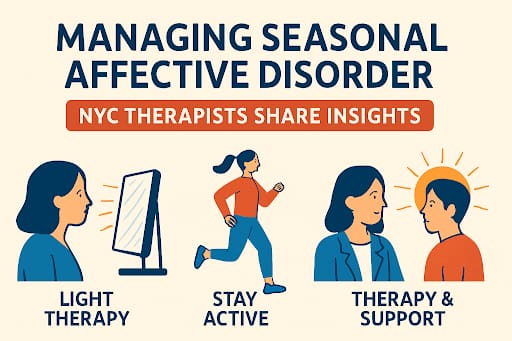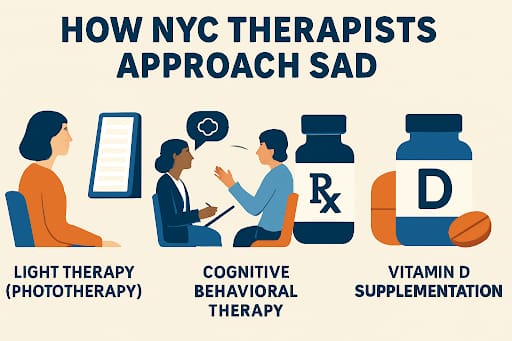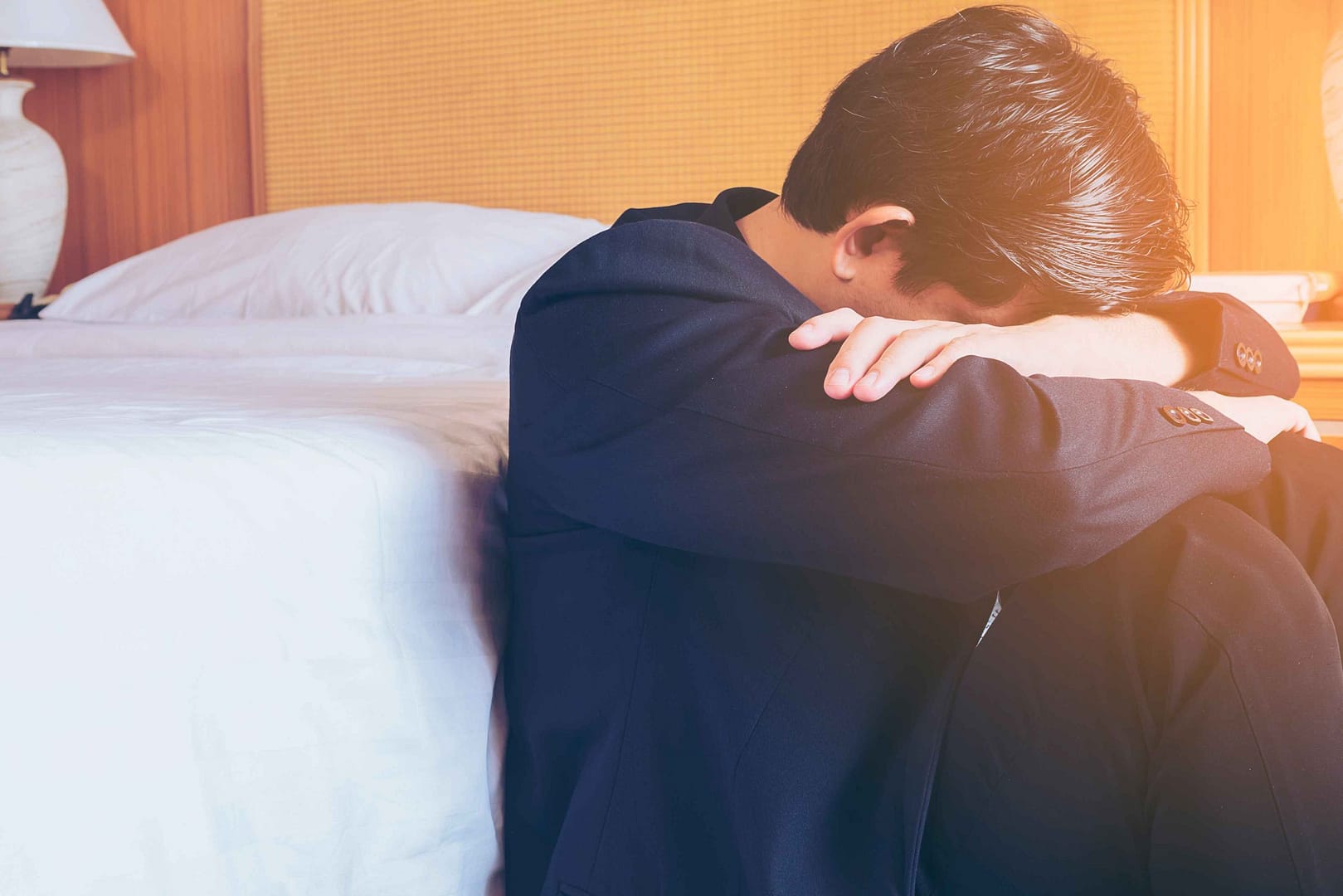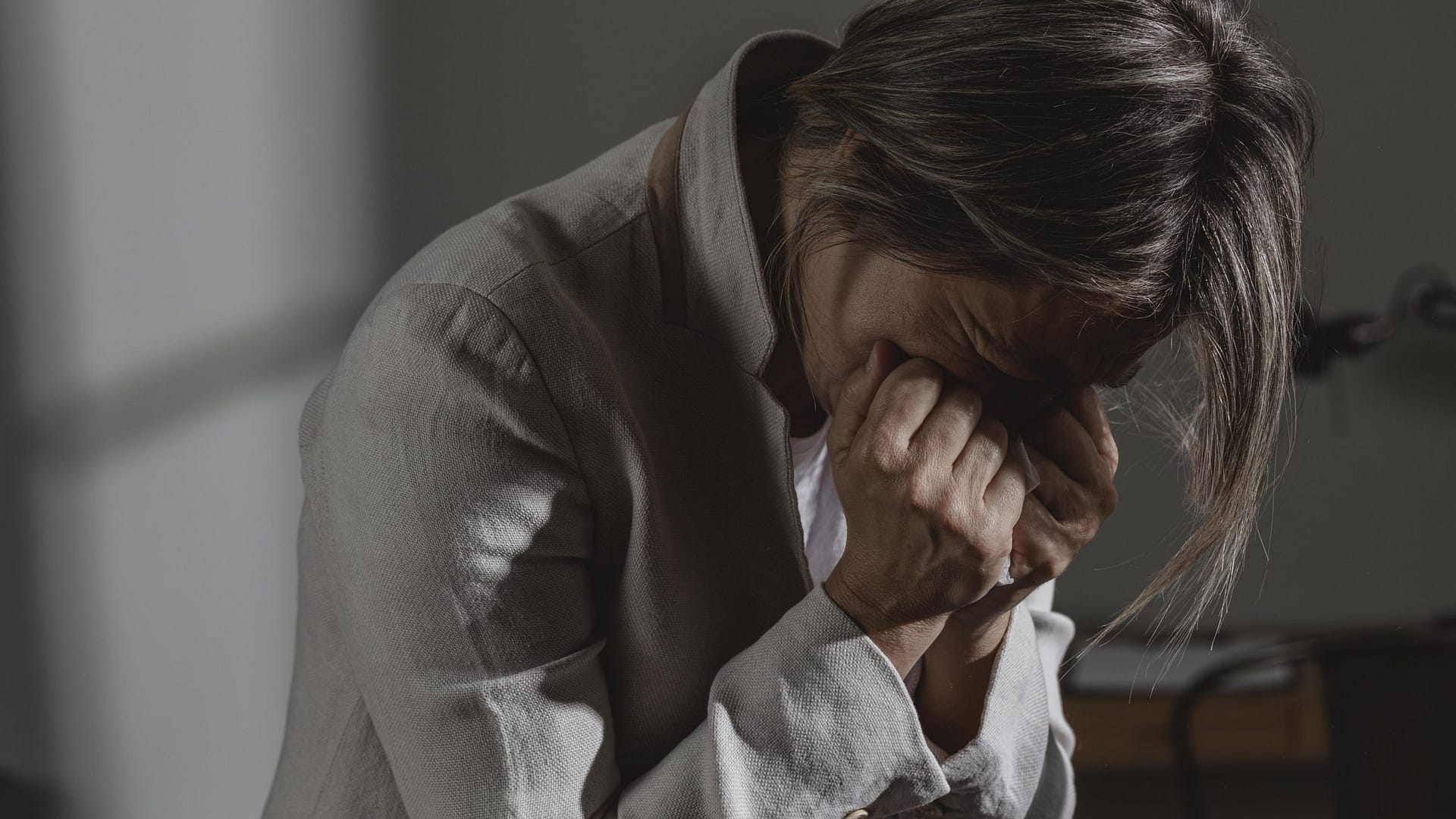Managing Seasonal Affective Disorder: NYC Therapists Share Insights

INTRODUCTION
As the summer sun turns to the gloomy grayness and cold crispness of winter, many people may recognize a change in their mental state that feels deeper than the typical winter blues. This change may indicate something called Seasonal Affective Disorder (SAD)—a type of depression that occurs with seasonal changes, primarily late fall and winter.
Plus, the stress of cold weather and less sunlight in rapid-paced NYC may leave some feeling emotionally vulnerable. With appropriate support, therapy, and coping techniques, it is possible to face and manage SAD, and in this blog, NYC therapists share their professional insights about dealing with and circumventing SAD.
What Is Seasonal Affective Disorder?
Seasonal Affective Disorder (SAD) is a type of depression that has a repeated seasonal pattern. SAD is displayed through changes over time related to the seasons, which most commonly is all about fall and winter, however summer-pattern SAD, which is less common, can show in the spring or the early summer.
When you experience SAD it is not the same change as normal feelings or moods; these symptoms can affect your functioning and overall life in a significant way.
- The winter-pattern SAD symptoms are: depressed mood most of the day, nearly every day, disinterest or loss of pleasure in activities, low energy/fatigue, hypersomnia, increased appetite (especially craving carbs), weight gain, diminished ability to concentrate, social withdrawal, and so on.
- NYC therapists note that SAD is often missed or dismissed as just the normal “seasonal blues” and if not addressed can easily progress to major depression. Early recognition is important.
Why Does SAD Happens? The Science Behind It
Seasonal Affective Disorder (SAD) arises from a combination of biological and environmental factors, particularly with regard to diminished sunlight exposure during the winter months.
In cities like New York, where tall buildings and busy lifestyles restrict the amount of available natural light, this diminishment disrupts the body’s natural biological clock, or circadian rhythm, which can bring on depressed feelings.
- Moreover, with less sunlight exposure, the brain produces more melatonin, a hormone which regulates sleep patterns, causing excessive fatigue, and tiredness in the darker winter months.
- At the same time, decreased sunlight exposure can lead to declines in serotonin levels, a neurotransmitter strongly linked to mood regulation, which can also lead to depressed moods.
- Another important contributor to SAD, which is as stated above a compound effect from light changes and hormonal balances, is sunlight exposure for vitamin D production, a nutrient one contributes to mood as well.
- Thus, for those who do not possess sufficient vitamin D in winter months that can lead to negative health effects in addition to SAD which is why this is a complex condition.
How NYC Therapists Approaches SAD

1. Light Therapy (Phototherapy)
Light therapy, now seen as phototherapy, is a very useful therapy for Seasonal Affective Disorder (SAD).
- Light therapy involves getting daily light exposure from a designated light box that mimics sunlight, usually giving off a brightness of 10,000 lux.
- Utilizing a light box in the first hour after waking can regulate the body’s circadian rhythm and increase serotonin levels, which can drastically improve mood.
- NYC therapists usually consider this a first line treatment due to the benefits and suggestions to be made by other therapists.
- Additionally, NYC therapists often recommend a general guideline to choose a UV-free, designated, SAD light box and utilize it daily for 20-30 minutes of exposure every day, and be properly supervised to ensure safe and effective results.
2. Cognitive Behavioral Therapy
Cognitive Behavioral Therapy (CBT) is a structured and evidence-based type of talk therapy that can be very useful when managing Seasonal Affective Disorder (SAD).
- Cognitive Behavioral Therapy can help individuals to recognise, question and reframe negative thoughts and behaviours which develop and contribute to other depressive symptoms.
- A therapist will always remember that not only the emotional burden associated with SAD is being treated, but also adds useful coping skills to the handling toolbox.
- As an example, thoughts such as “I’m never going to feel better until it’s spring” will be re- framed to develop a sense of hope and action among other useful coping skills.
- CBT can be done in person or virtually and will be very useful for some New Yorkers experiencing the challenges of winter.
3. Medication
For people suffering with moderate to severe Seasonal Affective Disorder (SAD), medication can be an important component of treatment.
- Selective serotonin reuptake inhibitors (SSRIs) such as sertraline, fluoxetine, and bupropion are frequently prescribed with good evidence for symptom relief.
- NYC psychiatrists point out that while medication won’t make SAD go away—there is no magic pill, after all—it can be a critical component when SAD is disrupting day-to-day functioning.
- It’s important to connect with a psychiatrist to determine what medication or treatment regimen is appropriate, along with the dosage.
- When prescribing medication to patients with SAD, a psychiatrist will often combine it with therapy, lifestyle changes or other treatment strategies to assist in addressing the condition.
Using multiple approaches tends to be most effective in treating SAD.
4. Vitamin D Supplementation
Vitamin D supplementation is frequently recommended as part of a multi-modal approach for Seasonal Affective Disorder (SAD) since many people with SAD have low vitamin D levels.
- It is common for therapists and medical practitioners to recommend a blood test for vitamin D deficiency before the initiation of supplements.
- Natural sunlight is the best source of vitamin D, but it can be hard to get enough during the dark winter months in NYC.
- If it is difficult to get enough natural sunlight, eating dietary sources such as fatty fish and fortified milk and/or supplementing in appropriate doses can help support mood and general well-being.
Lifestyle Modification - Daily Habits That Make a Difference
Lifestyle changes can be a profound tool to combat Seasonal Affective Disorder (SAD), especially when embedded into everyday processes.
- Make it a part of your daily routine to increase your exposure to natural light in the morning; as natural light will help regulate your circadian rhythm in the morning.
- You also want to focus on maintaining an active lifestyle, as exercise releases endorphins and increases serotonin levels.
- Therapists in NYC commonly recommend all of the above, including yoga, indoor cycling, freestyle dancing, and even using lunch breaks as opportunities for movement.
- In addition to exercise, maintain a healthy diet that includes good sources of omega-3s, lean protein, and complex carbohydrates.
- Most importantly, try your absolute best to limit your sugar intake, alcohol, and caffeine to avoid energy crashes and disrupted sleep cycle.
- Try to maintain a consistent sleep cycle by waking up and sleeping around the same time, as well as other factors that influence sleep.
- Evening and night time connections with friends are important, whether that involves attending a community event, connecting virtually/hybrid (ie: Meetup).
- Finally, consider mindfulness practices and gratitude practices. You can use a journal to practice mindfulness and gratitude, or apps like Calm or Headspace. Mindfulness practices can optimize emotional resilience and help reduce anxiety and stress.
Final Thought
Managing Seasonal Affective Disorder (SAD) should be intentional and multidimensional—more so in New York City, where the winter darkness can compound an already stressful life.
- NYC therapists recommend that someone with SAD incorporate various approaches, including light therapy, cognitive behavioral therapy, medication (if needed), taking vitamin D, and creating healthy habits around self-care.
- You can learn about it, and implement the right number of things to sustain your emotional balance and your mental health throughout the year.
Recovery is possible, and it is right in front of you, along with tools and support.
Reference
- Seasonal depression (Seasonal affective disorder). (2025, June 2). Cleveland Clinic. https://my.clevelandclinic.org/health/diseases/9293-seasonal-depression
- Campbell, P. D., Miller, A. M., & Woesner, M. E. (2017). Bright Light Therapy: Seasonal Affective Disorder and Beyond. The Einstein Journal of Biology and Medicine : EJBM, 32, E13. https://pmc.ncbi.nlm.nih.gov/articles/PMC6746555/
- Website, N. (2025, May 2). Treatment – Seasonal affective disorder (SAD). nhs.uk. https://www.nhs.uk/mental-health/conditions/seasonal-affective-disorder-sad/treatment/
- Seasonal affective disorder (SAD) – Diagnosis & treatment – Mayo Clinic. (2021, December 14). Mayo Clinic. https://www.mayoclinic.org/diseases-conditions/seasonal-affective-disorder/diagnosis-treatment/drc-20364722
- Praschak-Rieder, N., & Willeit, M. (2003). Treatment of seasonal affective disorders. Dialogues in Clinical Neuroscience, 5(4), 389. https://doi.org/10.31887/DCNS.2003.5.4/npraschakrieder
- Jahan-Mihan, A., Stevens, P., Medero-Alfonso, S., Brace, G., Overby, L. K., Berg, K., & Labyak, C. (2024). The Role of Water-Soluble Vitamins and Vitamin D in Prevention and Treatment of Depression and Seasonal Affective Disorder in Adults. Nutrients, 16(12), 1902. https://doi.org/10.3390/nu16121902






